2022 Prescription Trends
The market for prescription medicines in the United States was subject to major shifts in use across therapeutic areas in 2022, reflecting changes in patient health needs, the development, and availability of novel medicines, and complex market dynamics.
Most therapeutic areas saw increased prescription volume in 2022 but there were notable differences, with most changes in categories such as infectious diseases, ADHD medicines, mental health prescriptions (especially among young people), and a simultaneous decline in opioid use. At the same time, the US market saw a dramatic increase in the use of novel obesity drugs.
These trends in retail prescription volumes were among the significant shifts evidenced in the new report from the IQVIA Institute for Human Data Science titled, The Use of Medicines in the U.S. 2023: Usage and Spending Trends and Outlook to 2027.1
Figure 1. Adjusted dispensed prescriptions in 2022 (Mn) and percent growth from 2021.
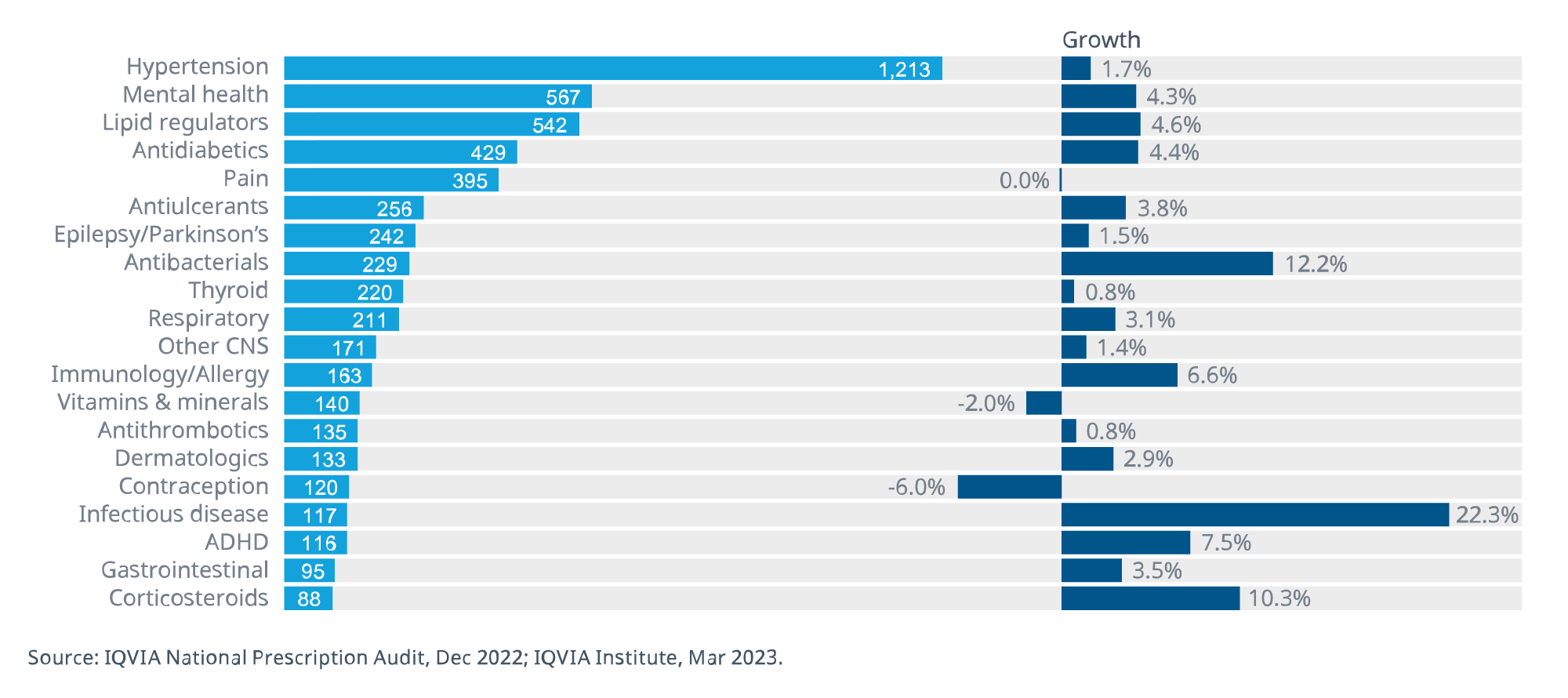
Figure 1 provides an overview of select key trends in the usage of medicines in the US in 2022. Overall, prescriptions across most major therapeutic areas increased in 2022 after disruptions in growth seen earlier in the pandemic and following notable shifts in use. The biggest increase took place in the use of medicines for infectious diseases at 22%, reflecting a season with severe respiratory illnesses that contributed to significant growth across a range of acute therapies, including 12.2% growth in antibacterial drugs.
Use of ADHD medicines
The use of medicines for attention-deficit/hyperactivity disorder (ADHD) exceeded 3 billion days of therapy in 2022, up from 2.8 billion in 2018 and 2.5 billion a decade ago (see Figure 2). Most notable is the increase in use among women aged 20-64, with this demographic segment now accounting for 33% of all prescriptions.
Growth in ADHD medicines remained stable from 2018–2020, declining on average less than 1% annually over the three years. However, after a substantial decline in Q2 2020 following the onset of the pandemic, use has risen significantly through 2021 and 2022 and is now up 11% from the 2018 level.
Figure 2. ADHD defined daily doses (DDDs) and share of prescriptions by age and gender from 2018–2022.
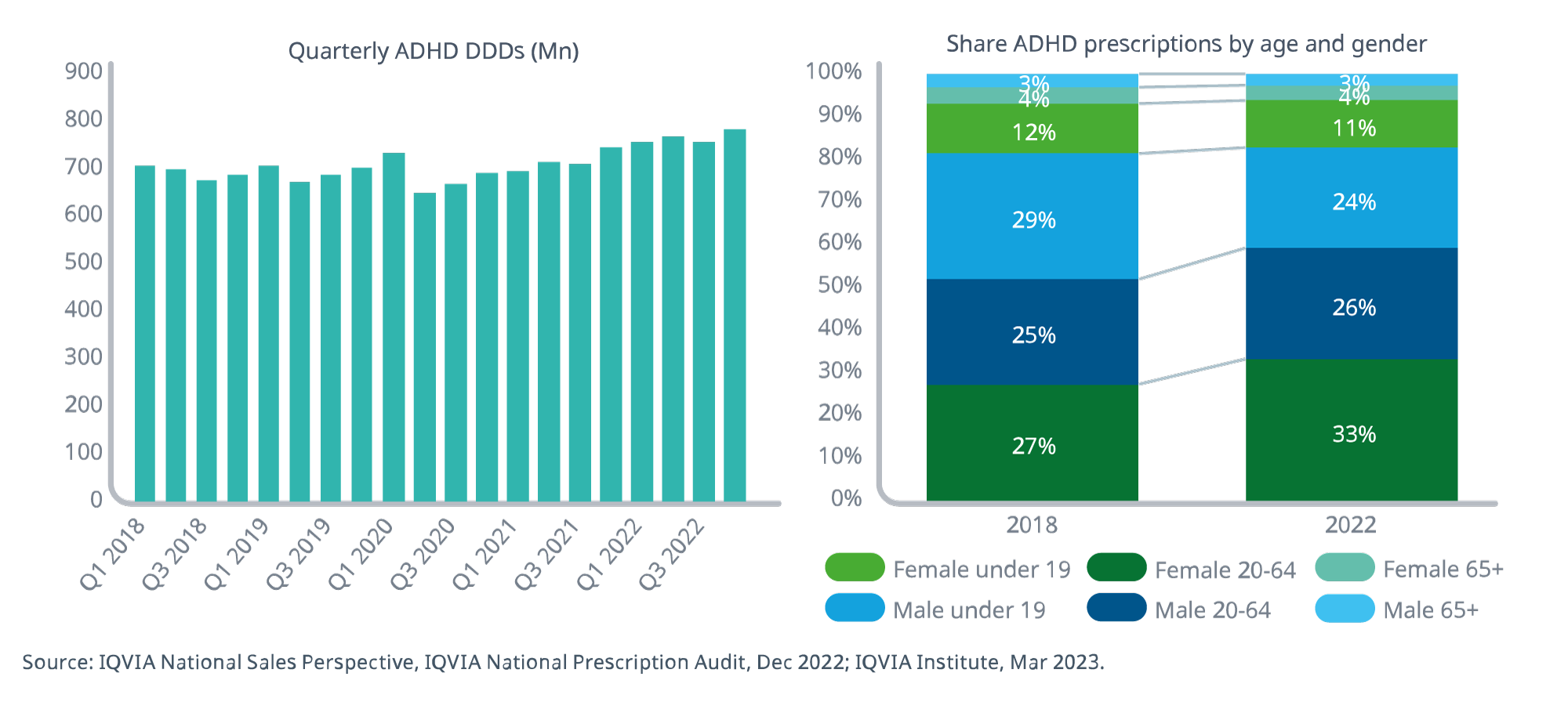
In 2018, boys under the age of 19 accounted for 29% of ADHD prescriptions and represented the largest share of prescriptions. Prescriptions in this age group were the most impacted by the pandemic, falling 7% below 2018 levels in 2020 and remaining 4% below in 2022. Adults aged 20–64 have seen the highest growth over the last five years, with prescriptions in women up 46% and in men up 26% from 2018, and women aged 20–64 now account for one third of prescriptions. These shifts in usage likely reflect the impacts of remote work on adults and increasing awareness of diagnosis criteria among clinicians.2
Mental health prescriptions rising among young women
Mental health prescriptions—unadjusted for length of prescription—across all ages and genders were up 8.1% in 2022 from 2019 levels compared to just 3.2% for all other medicines, as the pandemic exacerbated an ever-growing mental health crisis in the US (see Figure 3).
Girls under the age of 19 have experienced the highest growth in mental health prescriptions, up 33% from 2019. This coincides with a concerning trend noted by the Centers for Disease Control and Prevention (CDC) among high school students, where female students are more likely to experience poor mental health and suicidal thoughts and behaviors, and the percentage has increased more rapidly through 2022 than in male students.3
Figure 3. Mental health prescriptions indexed to 2019 values and 2022 shares by age and gender.
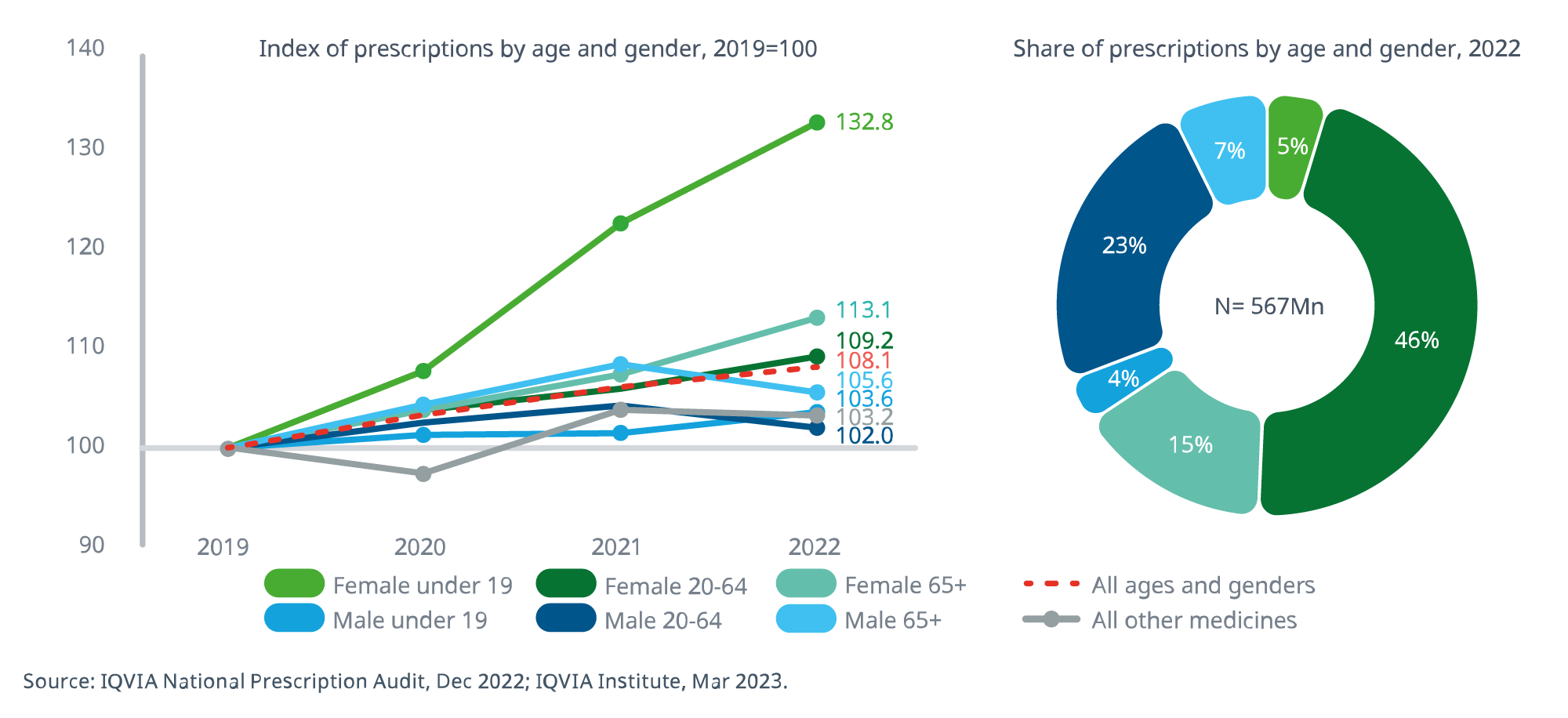
Ketamine, traditionally used for anesthesia and illicit recreational purposes, was approved for use in depression in 2019. Though use is limited to treatment-resistant depression and major depressive disorder, it has gained traction and was prescribed more than 100,000 times in 2022, which is more than triple the number of three years earlier.
While all age groups and genders saw increased usage of mental health prescriptions, there are apparent differences in usage between males and females, with females accounting for two-thirds of prescriptions in 2022 and women aged 20–64 accounting for 46%.
A decline in opioid prescriptions
Prescription opioid volume declined for the eleventh consecutive year after peaking in 2011. However, deaths from overdoses continue to rise (see Figure 4).
In 2022, the use of opioids declined by 7.4% to 95 billion morphine milligram equivalents (MMEs), with per capita levels down 64% from the peak year of 2011 and dropping back to levels of use last seen in the year 2000.
The greatest reductions in prescription opioid volume have been in higher-risk segments receiving greater than 90 MMEs per day. These decreases in volume have been driven by changes in clinical usage, regulatory and reimbursement policies, and progressively more restrictive legislation enacted since 2012, including class-wide guidance from FDA in 2016.
Figure 4. Prescription opioid use and opioid-involved overdose deaths.
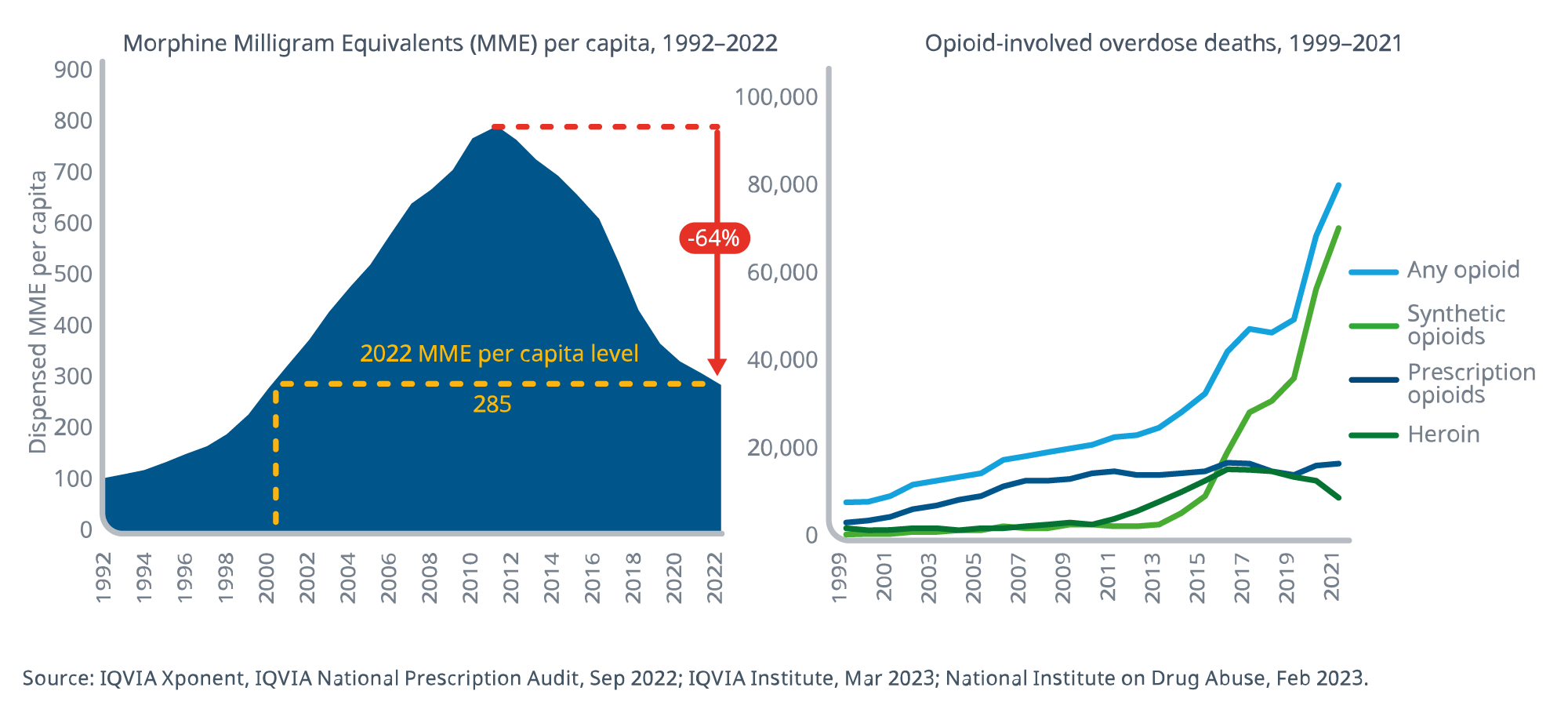
Despite significant progress in reducing opioid prescriptions to combat the opioid overdose epidemic, overdose deaths have been rising primarily due to illicit synthetic opioids. Overdose deaths involving prescription opioids averaged nearly 16,000 annually from 2017–2021 and were declining prior to the pandemic but experienced setbacks in 2020 and 2021.
Provisional numbers from the CDC indicate prescription opioid overdose deaths may have trended downward again in 2022.4
Dramatic growth in novel therapies for obesity
In 2022, significant growth was seen in the use of novel drugs for diabetes, up 21% compared to the prior year, with GLP-1 agonist use rising across both diabetes and obesity and up 152% in early 2023 compared to the prior year (see Figure 5).
Figure 5. Adjusted diabetes prescriptions by type and GLP-1 agonist new prescriptions by indication.
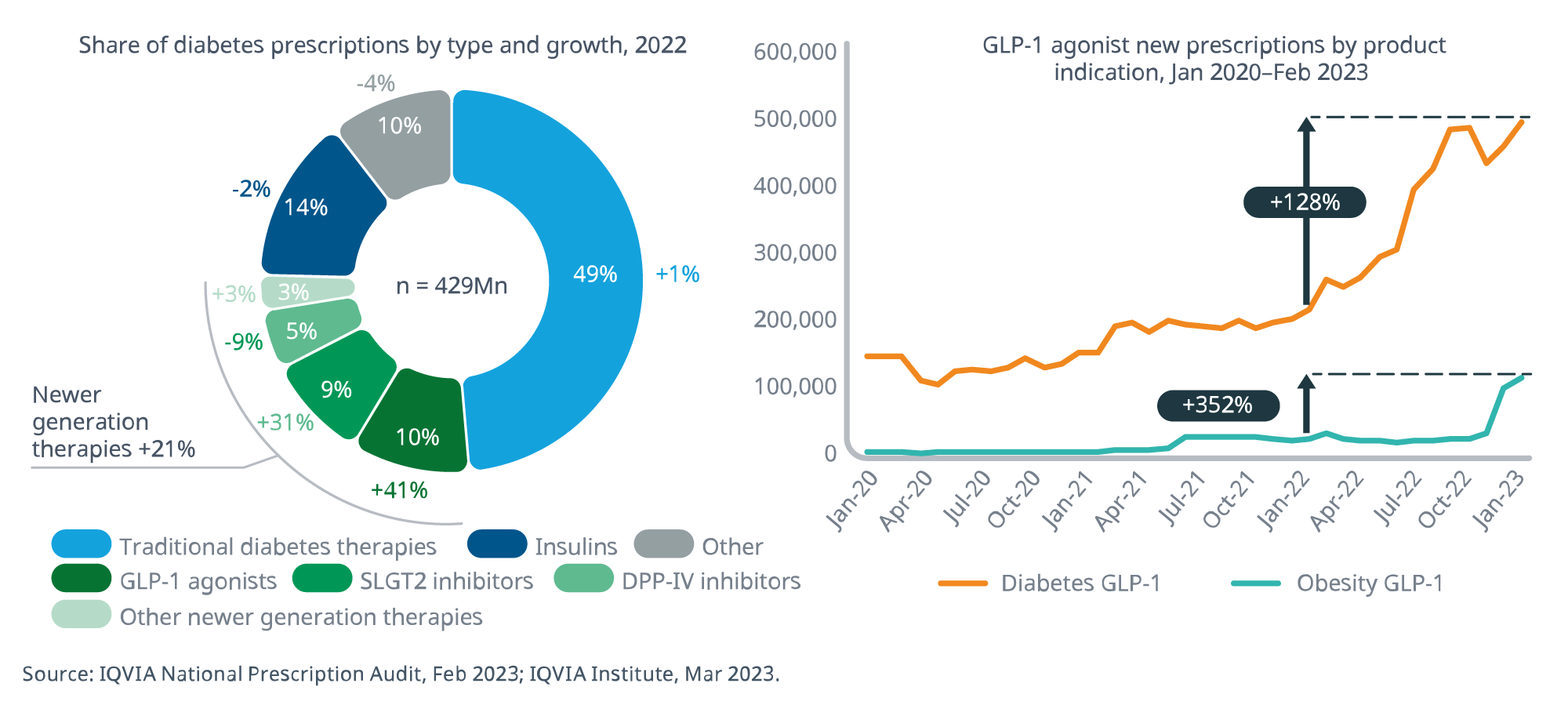
In 2022, 429 million prescriptions were dispensed to treat diabetes, increasing 4.4% in 2022 and 7.9% over the last two years. Nearly half of the diabetes prescriptions in 2022 were for traditional therapies, including metformin and sulphonylureas—with metformin accounting for 74% of traditional diabetes therapies. Insulins, which have received significant attention related to out-of-pocket costs, account for 14% of diabetes prescriptions and have been declining in use, down 2% in 2022.
Newer-generation diabetes therapies, including DPP-IV inhibitors, SGLT2 inhibitors, and GLP-1 agonists, have had high growth in recent years and registered a combined increase of 21% in 2022.
GLP-1 agonists were the fasting growing class of diabetes medicines in 2022, growing 41%. Some of these medicines are approved for treating both diabetes and obesity, but under different products, at different dosages, and with different prescribing information. GLP-1 agonists across both diabetes and obesity saw rapid increases in new prescriptions at the end of 2022 and early in 2023, with new diabetes prescriptions up 128% in February 2023 compared to the prior year and obesity prescriptions (up 352%).
The increasing popularity of GLP-1 agonists led to shortages in 2022 for semaglutide, which is approved for use as Ozempic and Wegovy in diabetes and obesity, respectively, potentially leaving existing patients to find alternative options.
Summary
The most notable shifts in the use of prescription medicines in 2022 reflected changes in patient health needs, the development and availability of novel medicines, and market dynamics. The most significant changes took place in the following areas:
- The increase in anti-infective and anti-bacterial drugs to address a season of severe respiratory illness
- The growth in medicines for attention-deficit/hyperactivity disorder (ADHD)
- The rise in mental health prescriptions, especially among young women in response to the growing mental health crisis
- The rapid growth in the use of GLP-1 agonists across both diabetes and obesity
References
- IQVIA, The Use of Medicines in the U.S. 2023: Usage and Spending Trends and Outlook to 2027 (May 2, 2023), https://www.iqvia.com/insights/the-iqvia-institute/reports/the-use-of-medicines-in-the-us-2023
- Ahmad S. Is ADHD becoming more common? Psychology Today (Feb. 10, 2023), https://www.psychologytoday.com/us/blog/balanced/202302/why-is-the-prevalence-of-adhd-increasing
- CDC National Center for HIV, Viral Hepatitis, STD, and TB Prevention. Youth Risk Behavior Survey Data Summary & Trends Report: 2011–2021 (February 2023) https://www.cdc.gov/healthyyouth/data/yrbs/pdf/YRBS_Data-Summary-Trends_Report2023_508.pdf
- CDC National Center for Health Statistics. Provisional Drug Overdose Death Counts (accessed April 12, 2023), https://www.cdc.gov/nchs/nvss/vsrr/drug-overdose-data.htm
About the author
Jamie Pritchett

Jamie Pritchett is an associate thought leadership director for the IQVIA Institute, managing aspects of IQVIA Institute projects and conducting research and analysis within global healthcare.
Regeneron, Roche Launch Major US Expansion Plans to Meet Growing Demand for Biologics and Innovation
April 22nd 2025With combined investments exceeding $53 billion, both companies are deepening their US presence through expanded biologics production, gene therapy capabilities, and next generation R&D centers.
Cell and Gene Therapy Check-in 2024
January 18th 2024Fran Gregory, VP of Emerging Therapies, Cardinal Health discusses her career, how both CAR-T therapies and personalization have been gaining momentum and what kind of progress we expect to see from them, some of the biggest hurdles facing their section of the industry, the importance of patient advocacy and so much more.